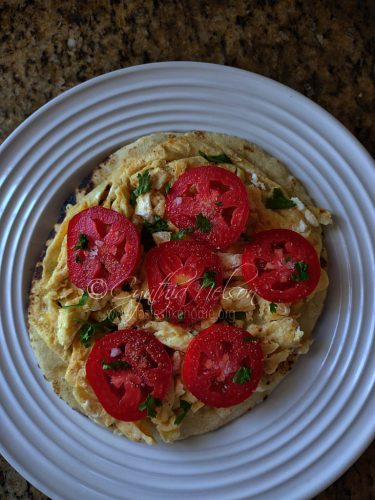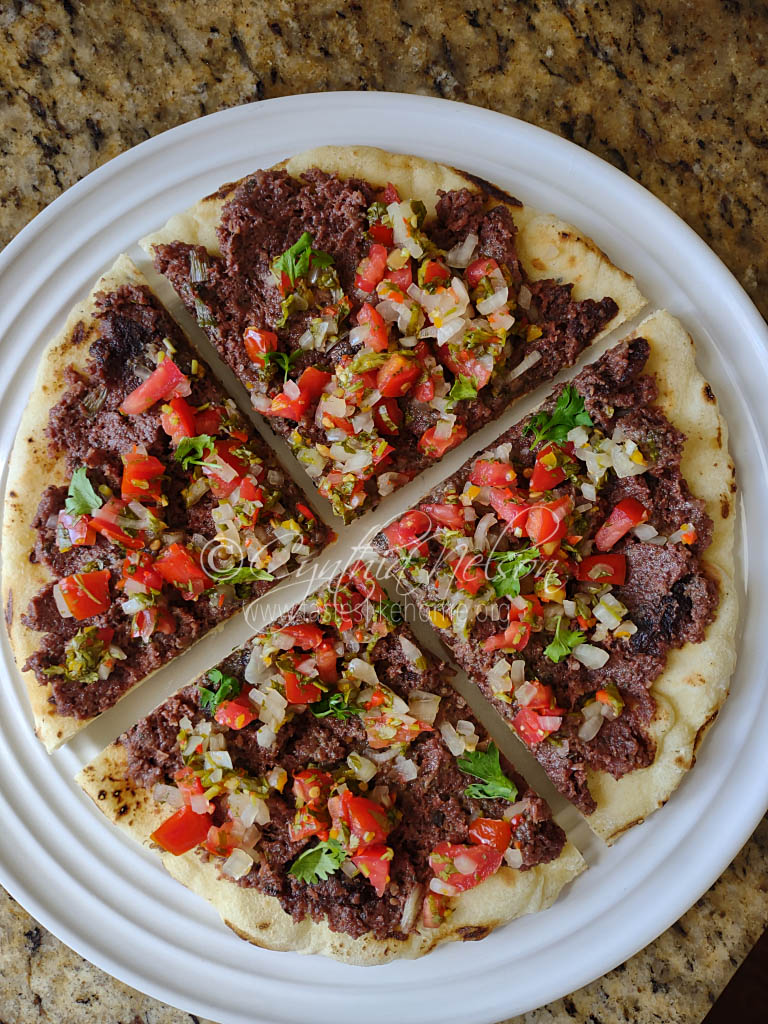 To eat Sada roti, we traditionally tear it or cut it into quarters. We also cut or pry it open so that we have two layers for tearing into smaller pieces for dipping into Baingan (eggplant) or Tomato choka, or as I wrote a couple of weeks ago, slathering with butter. Well, for the past week, instead of tearing, cutting, dipping, and slathering, I have been topping my Sada roti, giving it another type of treatment, after all, it is a type of flatbread.
To eat Sada roti, we traditionally tear it or cut it into quarters. We also cut or pry it open so that we have two layers for tearing into smaller pieces for dipping into Baingan (eggplant) or Tomato choka, or as I wrote a couple of weeks ago, slathering with butter. Well, for the past week, instead of tearing, cutting, dipping, and slathering, I have been topping my Sada roti, giving it another type of treatment, after all, it is a type of flatbread.

Sada roti is the type of roti that each household prefers in a particular way, whether it is the meal at which it is consumed – breakfast or dinner; what it is eaten with or by the size and thickness. My late Mother liked large Sada roti, about 9 inches in diameter and thick, rolled ½ to ¾-inch thick. It would be cooked low and slow on the tawa, and she’d often cover it with an enamel bowl creating a stovetop oven-like environment. During the cooking process, the roti would be flipped, and the other side would be cooked uncovered and then the finishing touch – pulling the tawa to reveal the flames and pushing and turning the roti directly over the fire to char the edges and help it puff up.
On the other hand, I’d seen my late Auntie Betty make her Sada roti smaller, about 6 inches in diameter with a little more than ¼-inch thickness. Then in Trinidad, I’d seen family friends make Sada roti in varying sizes, as large as 10 inches round, smaller than my Aunt’s and anywhere in between, however, the roti would be rolled thin, a little less than ¼-inch. The taste and flavour of each roti was the same, the difference really lay in the size and thickness. And in every case the roti was eaten torn, even if it had been quartered to make it more manageable to handle.
When I make Sada roti, it varies. If I am feeling lazy, they are large and thick like Mom’s which makes them good for slicing and buttering or making into a sandwich; if I am eating it with a choka or chutney, then they are smaller like my Aunt’s. Of late though, I have been making them thin like the Trinis, because they are best that way for topping with a variety of things that I can eat for breakfast, lunch, or dinner. They are thin enough to work light as a flat bread without being doughy, and small enough to be eaten as a full and satisfying meal.
So here’s how the idea of topping the Sada roti came about. A very good friend brought Black Pudding for me from Trinidad. I have loved it ever since I first had it several years ago. It is different from our Guyanese Black Pudding. Trinidad’s Black Pudding filling is primarily made of pig’s blood with some people adding offal such as liver or bread to give a little body to the filling when cooked in the casing. The texture, when cooked, is soft with the filling thick and spreadable. It is very flavourful from the variety of seasonings added and the taste varies with each maker putting their signature flavour ingredients by the use of a combination of herbs and spices. Gosh, I love when it gets heated a little in a pan or griddle, the edges get a little toasty and it’s topped with lashings of pepper sauce – slight, medium, or heavy. So very good!

Anyway, back to the Sada roti and topping. One morning, I woke up and heated up some of the black pudding to have for breakfast and wondered what to eat it with, then I remembered that I had Sada roti (the thin type) which I’d made the day before. I reheated my roti, squeezed the filling from the Black Pudding and smeared it thickly over the roti. Instead of pepper sauce, I took some of the Pico de gallo I had in the refrigerator and scattered it over the surface of the Black Pudding, knowing it would bring freshness, heat, and a hint of tartness from the lime juice with which it was made. I then cut it into quarters for easy eating. Oh. My. Goodness. The combination was absolutely delicious. And it wasn’t just the Black pudding that I found appealing but the Sada roti in combination with the Black pudding. It was the right level of thinness that made the meal filling and not bready. It also had the perfect heft to carry the topping. The next day, I couldn’t wait to find other things to top my Sada roti.
One day, I topped it with scrambled eggs and sliced tomatoes and another with crunchy peanut butter, bananas and a drizzle of honey. That was a lovely treat. Since then, I’ve been listing things to top my Sada roti, and I’d like you to give it a try too. The key here is to find things that are spreadable that will adhere to the roti.
· Tuna spread with pickled red onions
· Corned beef paste with sauteed onions
· Cheese paste with chopped tomatoes
· Jam with crumbled bacon
· Guacamole
Actually, most things that you think would make a good spread for bread would work generously smeared on Sada roti. Two key things here – make the Sada roti thin and think outside the box of how you perceive Sada roti. You might also want to consider eating some of the usual accompaniments but in a different way. For example, spread the baigain choka on top of the Sada roti.
If you’re planning to try this and I hope you do, roll the Sada roti no more than 6 inches round and thin. The structure of the dough for this type of roti will keep its integrity when cooked, though rolled thin. I am suggesting 6 inches round for two main reasons – it is a good portion size for a single serving and unless you have a 10, 12 or 13-inch tawah then this size will fit comfortably on an average tawah.
Cynthia










